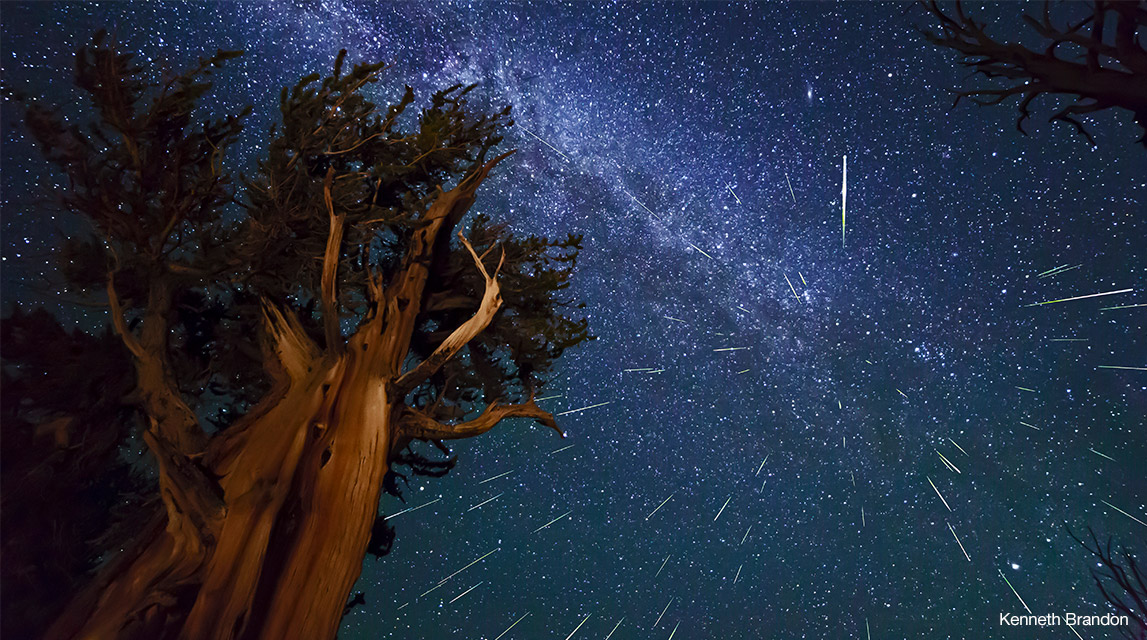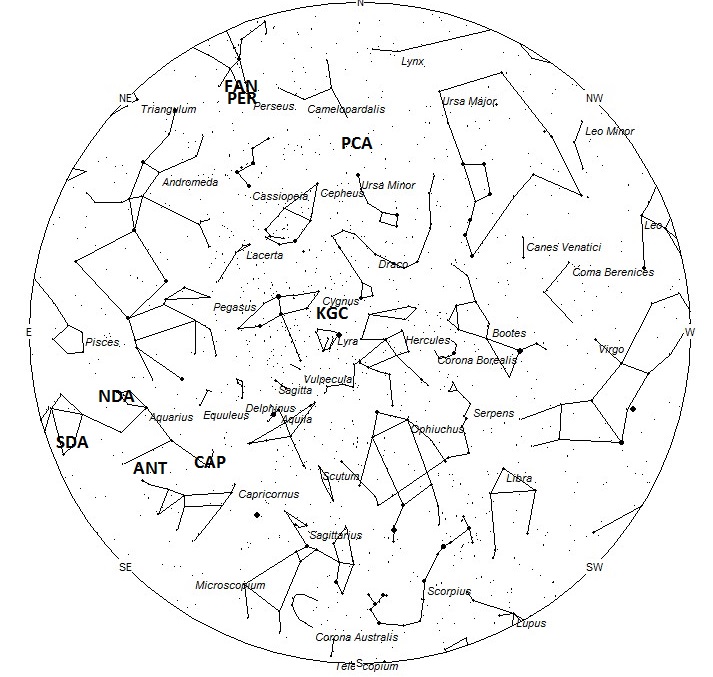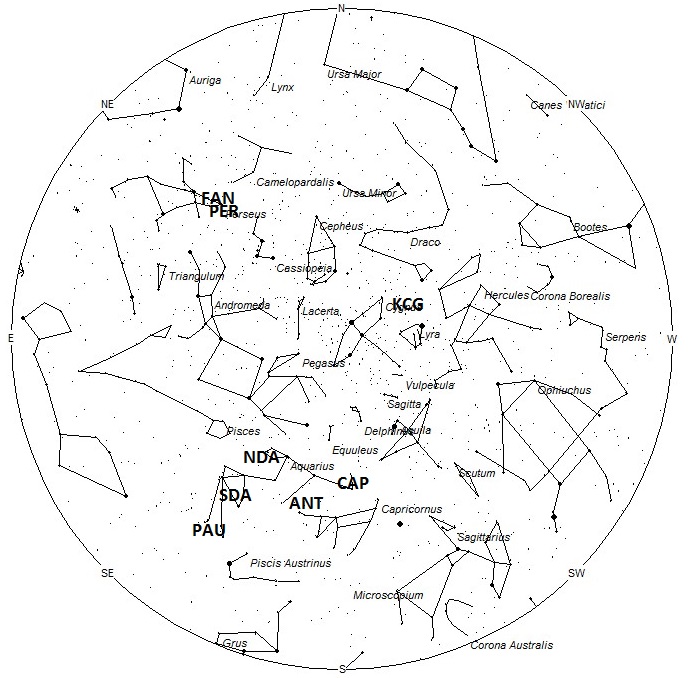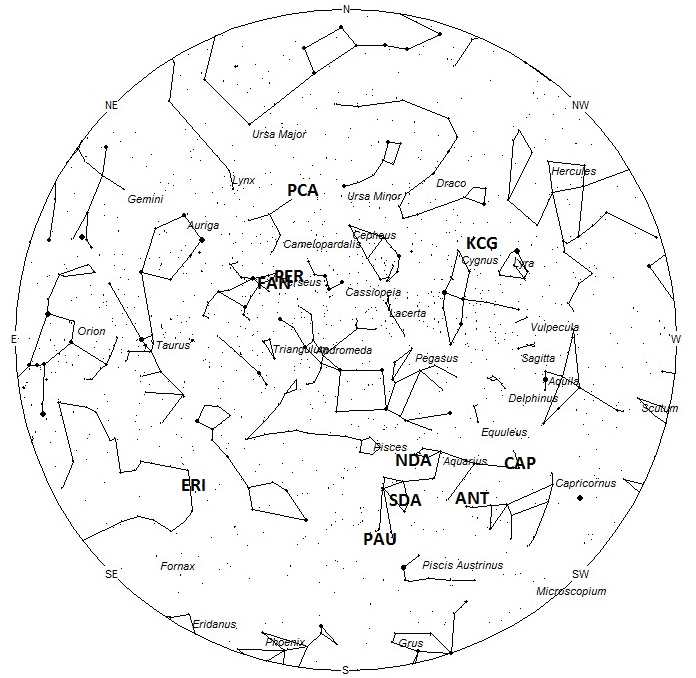
Composite (73 photos with meteors) / Canon 6D 20s 10000ISO / Rokinon 14mm 2.8 @2.8 / Time-Lapse of 900+ images /11:20PM-4:30AM – © Kenneth Brandon
During this period the moon will reach its full phase on Monday August 7. At this time the moon will be located opposite the sun and will lie above the horizon all night long. This is the worst time to try and view meteor activity this month as the bright moon will obscure all but the brighter meteors. The estimated total hourly meteor rates for evening observers this week is near 2 for those viewing from the northern hemisphere and 1 for those located south of the equator. For morning observers the estimated total hourly rates should be near 20 as seen from mid-northern latitudes and 13 from the southern tropics. The actual rates will also depend on factors such as personal light and motion perception, local weather conditions, alertness and experience in watching meteor activity. Rates are reduced during this period due to interfering moonlight. Note that the hourly rates listed below are estimates as viewed from dark sky sites away from urban light sources. Observers viewing from urban areas will see less activity as only the brighter meteors will be visible from such locations.
The radiant (the area of the sky where meteors appear to shoot from) positions and rates listed below are exact for Saturday night/Sunday morning August 5/6. These positions do not change greatly day to day so the listed coordinates may be used during this entire period. Most star atlases (available at science stores and planetariums) will provide maps with grid lines of the celestial coordinates so that you may find out exactly where these positions are located in the sky. A planisphere or computer planetarium program is also useful in showing the sky at any time of night on any date of the year. Activity from each radiant is best seen when it is positioned highest in the sky, either due north or south along the meridian, depending on your latitude. It must be remembered that meteor activity is rarely seen at the radiant position. Rather they shoot outwards from the radiant so it is best to center your field of view so that the radiant lies at the edge and not the center. Viewing there will allow you to easily trace the path of each meteor back to the radiant (if it is a shower member) or in another direction if it is a sporadic. Meteor activity is not seen from radiants that are located far below the horizon. The positions below are listed in a west to east manner in order of right ascension (celestial longitude). The positions listed first are located further west therefore are accessible earlier in the night while those listed further down the list rise later in the night.
These sources of meteoric activity are expected to be active this week.
Detailed descriptions of each meteor stream will continue next week when interference from the moon is not so bad.
| SHOWER | DATE OF MAXIMUM ACTIVITY | CELESTIAL POSITION | ENTRY VELOCITY | CULMINATION | HOURLY RATE | CLASS |
| RA (RA in Deg.) DEC | Km/Sec | Local Daylight Saving Time | North-South | |||
| kappa Cygnids (KCG) | Aug 13 | 18:48 (282) +46 | 22 | 23:00 | <1 – <1 | II |
| alpha Capricornids (CAP) | Jul 27 | 20:48 (312) -08 | 22 | 01:00 | 1 – 1 | II |
| Anthelions (ANT) | – | 21:44 (326) -13 | 30 | 02:00 | 1 – 2 | III |
| Northern delta Aquariids (NDA) | Aug 14 | 22:40 (340) -01 | 38 | 03:00 | <1 – <1 | IV |
| Southern delta Aquariids (SDA) | Jul 30 | 23:08 (347) -14 | 41 | 04:00 | 2 – 3 | I |
| Piscids Austrinids (PAU) | Aug 08 | 23:24 (351) -21 | 44 | 04:00 | <1 – <1 | IV |
| Perseids (PER) | Aug 12 | 02:32 (038) +56 | 59 | 06:00 | 10 – 3 | I |
| eta Eridanids (ERI) | Aug 11 | 02:40 (040) -14 | 65 | 06:00 | 1 – 1 | IV |
| 49 Andromedids (FAN) | Jul 21 | 02:46 (042) +54 | 60 | 06:00 | <1 – <1 | IV |
| psi Cassiopeiids (PCA) | Jul 22 | 04:00 (060) +78 | 42 | 08:00 | <1 – <1 | IV |
 American Meteor Society
American Meteor Society



Dear Robert: yesterday over Coronado, California, we saw a magnificent shooting star that split in two
Liliana and All,
Rats, I wish I could have seen it 🙁
Robert Lunsford